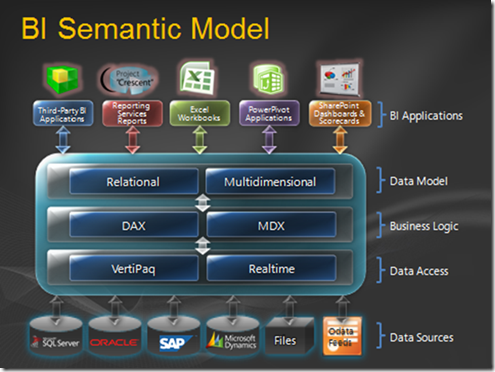SQL Server ‘Denali’-BI Semantic Model (BISM)
(Copied from SQL Server Team blog)
A new Business Intelligence Semantic Model (BISM) in Analysis Services that will power Crescent as well as other Microsoft BI front end experiences such as Excel, Reporting Services and SharePoint Insights.
The BI Semantic Model is a relational (tables and relationships) model with BI artifacts such as hierarchies and KPIs. It unifies the capabilities of SMDL models with many of the sophisticated BI semantics from the UDM. However it does not replace the UDM.
The BI Semantic Model can be viewed as a 3-layer model:
- The Data Model layer that is exposed to client applications. Even though the BISM model is fundamentally relational, it can expose itself using both relational as well as multidimensional interfaces. OLAP-aware client applications such as Excel can consume the multidimensional interface and send MDX queries to the model. On the other hand, a free-form reporting application such as Crescent can use the relational interface and send DAX queries.
- The Business Logic layer that encapsulates the intelligence in the model. The business logic is created by the model author using DAX (Data Analysis Expressions) or MDX (Multidimensional Expressions). DAX is an expression language based on Excel formulas that was introduced in PowerPivot and built on relational concepts. It does not offer the power and flexibility that MDX does, but it is simpler to use and requires minimal tuning. There will always be sophisticated BI applications that need the power of MDX calculations and we envision that the BI Semantic Model will offer the choice of MDX as well, but this will likely come in a release after Denali.
- The Data Access layer that integrates data from various sources – relational databases, business applications, flat files, OData feeds, etc. There are two options for data access – cached and realtime. The cached mode pulls in data from all the sources and stores in the VertiPaq in-memory column store. VertiPaq is a breakthrough technology that encapsulates state-of-art data compression algorithms along with a sophisticated multi-threaded query processor that is optimized for the latest multi-core chipsets, thereby delivering blazing fast performance with no need for indexing, aggregates or tuning. The realtime mode, on the other hand, is a completely passthrough mode that pushes the query processing and business logic evaluation down to the data source, thereby exploiting the capabilities of the source system and avoiding the need to copy the data into the VertiPaq store. Obviously there is a tradeoff between these two modes (the high performance of VertiPaq versus the latency and overhead associated with copying the data into VertiPaq) and that choice is left to the model author.
The BI Semantic Model can be authored by BI professionals in the Visual Studio 2010 environment using a new project type that will be available as part of “Project Juneau”. Juneau is an integrated development environment for all of SQL Server and subsumes the Business Intelligence Development Studio (BIDS). When a business user creates a PowerPivot application, the model that is embedded inside the workbook is also a BI Semantic Model. When the workbook is published to SharePoint, the model is hosted inside an SSAS server and served up to other applications and services such as Excel Services, Reporting Services, etc. Since it is the same BI Semantic Model that is powering PowerPivot for Excel, PowerPivot for SharePoint and Analysis Services, it enables seamless transition of BI applications from Personal BI to Team BI to Organizational (or Professional) BI.
